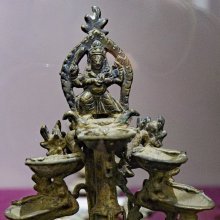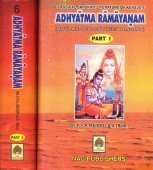Pancavati, Pañcavaṭī, Pancan-vati, Pamcavati: 6 definitions
Introduction:
Pancavati means something in Hinduism, Sanskrit, the history of ancient India, Tamil. If you want to know the exact meaning, history, etymology or English translation of this term then check out the descriptions on this page. Add your comment or reference to a book if you want to contribute to this summary article.
Alternative spellings of this word include Panchavati.
Images (photo gallery)
In Hinduism
Purana and Itihasa (epic history)
Source: archive.org: Puranic EncyclopediaPañcavaṭī (पञ्चवटी).—The sacred place where Śrī Rāma built an āśrama and lived for some time with Sītā and Lakṣmaṇa during their exile in the forests. There is a story about Pañcavaṭī in the Kamba Rāmāyaṇa.
Pañcavaṭī is on the southern bank of the Godāvarī. Five Vaṭavṛkṣas (banyan trees) stand here in a circle and therefore, the place got the name Pañcavaṭī. There is a legend about these banyan trees. Once five Gandharva youths encircled the sage Agastya in the forest as a sport and prevented him from moving towards any direction. The enraged sage cursed them to stand in the same position as banyan trees. Thus by obstructing the movements of a divine man they were forced to remain without movement as trees. Before they took the form of trees they begged the sage for deliverance from the curse. Agastya said, "One day Śri Rāma with his wife and brother will come and stay in an āśrama built in your midst. Their holy presence will give you salvation from my curse."
Śrī Rāma and Lakṣmaṇa when they came to that forest decided to build an āśrama in the centre of the circle formed by the five banyan trees. Lakṣmaṇa started to build the hermitage. At first he cut down one of the trees standing tall and straight and to the surprise and astonishment of all the fallen trunk of the tree disappeared and there in its place lay the dead body of a demon youth. It was the body of Śambhukumāra, son of Śūrpaṇakhā. He was doing penance there when Śrī Rāma came there with Sītā and becoming lustful at the sight of Sītā he stood there as a tree. It was he who was cut down by Lakṣmaṇa.
Śrī Rāma understood the thing that happened. He then explained to Sītā and Lakṣmaṇa many things about the frauds and deceits of the demons. After that they built their hermitage there and dwelt there for a long time. (Araṇya Kāṇḍa, Kamba Rāmāyaṇa).

The Purana (पुराण, purāṇas) refers to Sanskrit literature preserving ancient India’s vast cultural history, including historical legends, religious ceremonies, various arts and sciences. The eighteen mahapuranas total over 400,000 shlokas (metrical couplets) and date to at least several centuries BCE.
India history and geography
Source: archive.org: Chaitanya’s life and teachings (history)Pancavati is one of the places visited by Chaitanya during his pilgrimage in Southern India between April 1510 and January 1512.—Panchavati.—Identified with Nasik in the Bombay presidency. Nasik and Trimbak (at the source of the Godavari) are described in Bombay Gazetteer, xvi.

The history of India traces the identification of countries, villages, towns and other regions of India, as well as mythology, zoology, royal dynasties, rulers, tribes, local festivities and traditions and regional languages. Ancient India enjoyed religious freedom and encourages the path of Dharma, a concept common to Buddhism, Hinduism, and Jainism.
Languages of India and abroad
Sanskrit dictionary
Source: DDSA: The practical Sanskrit-English dictionaryPañcavaṭī (पञ्चवटी).—
1) the five fig-trees: i. e. अश्वत्थ, बिल्व, वट, धात्री (aśvattha, bilva, vaṭa, dhātrī) and अशोक (aśoka).
2) Name of a part of the Daṇḍakā forest where the Godāvarī rises and where Rāma dwelt for a considerable time with his beloved; it is two miles from Nasik; परिहरन्तमपि मामितः पञ्चवटीस्नेहो बलादाकर्षतीव (pariharantamapi māmitaḥ pañcavaṭīsneho balādākarṣatīva) Uttararāmacarita 2.27/28; R.13.34.
Pañcavaṭī is a Sanskrit compound consisting of the terms pañcan and vaṭī (वटी).
Source: Cologne Digital Sanskrit Dictionaries: Monier-Williams Sanskrit-English Dictionary1) Pañcavaṭī (पञ्चवटी):—[=pañca-vaṭī] [from pañca-vaṭa > pañca] f. the 5 fig-trees (Name applied to Aśvattha, Bilva, Vaṭa, Dhātri, and Aśoka), [Skanda-purāṇa]
2) [v.s. ...] (also n.) Name of a part of the great southern forest where the Godāvarī rises and where the banished Rāma resided, [Mahābhārata; Rāmāyaṇa; Raghuvaṃśa]
Sanskrit, also spelled संस्कृतम् (saṃskṛtam), is an ancient language of India commonly seen as the grandmother of the Indo-European language family (even English!). Closely allied with Prakrit and Pali, Sanskrit is more exhaustive in both grammar and terms and has the most extensive collection of literature in the world, greatly surpassing its sister-languages Greek and Latin.
Kannada-English dictionary
Source: Alar: Kannada-English corpusPaṃcavaṭi (ಪಂಚವಟಿ):—[noun] an ornamental string made of hair, worn on the breast.
--- OR ---
Paṃcavaṭi (ಪಂಚವಟಿ):—[noun] (pl.) the five trees peepul (bo tree), beal (Aegle marmelos), banyan (Ficus benghalensis), Indian oak (Barringtonia acutangula), and Asoka (Jonesia asoca).
Kannada is a Dravidian language (as opposed to the Indo-European language family) mainly spoken in the southwestern region of India.
Tamil dictionary
Source: DDSA: University of Madras: Tamil LexiconPañcavaṭi (பஞ்சவடி) noun < pañca-vaṭī. The sacred grove of five banyans on the banks of the Godāvari, where Sītā was abducted by Rāvaṇa; கோதாவரிக்கரையிலுள்ளதும், ஐந்து ஆல மரங்கள் சேர்ந்திருக்கப்பெற்றதும் சீதாபிராட்டியை இராவணன் கவர்ந்துசென்ற இடமுமான தலம். பாங் கருளதாலுறையுள் பஞ்சவடி மஞ்ச [kothavarikkaraiyilullathum, ainthu ala marangal sernthirukkapperrathum sithapirattiyai iravanan kavarnthusenra idamumana thalam. pang karulathaluraiyul panchavadi mancha] (கம்பராமாயணம் அகத். [kambaramayanam agath.] 57).
--- OR ---
Pañcavaṭi (பஞ்சவடி) noun < pañca-vaṭa. Sacred thread of hair; மயிர்க்கயிற்றாலாகிய பூணூல். பஞ்சவடி மார்பினானை [mayirkkayirralagiya punul. panchavadi marpinanai] (தேவாரம் [thevaram] 228, 5).
Tamil is an ancient language of India from the Dravidian family spoken by roughly 250 million people mainly in southern India and Sri Lanka.
See also (Relevant definitions)
Starts with: Pancavatimahatmya, Pancavatiya.
Full-text: Pancavatimahatmya, Nasikya, Sarpasya, Mahamali, Mahakapala, Shurpanakha, Prithugriva, Sthulaksha, Agastyashrama, Godavari, Nasika.
Relevant text
Search found 14 books and stories containing Pancavati, Pañcavaṭī, Pancan-vati, Pañcan-vaṭī, Panca-vati, Pañca-vaṭī, Pamcavati, Paṃcavaṭi, Pañcavaṭi, Pancavaṭi, Panca-vaṭi, Panchavadi, Panchvadi, Panjavadi; (plurals include: Pancavatis, Pañcavaṭīs, vatis, vaṭīs, Pamcavatis, Paṃcavaṭis, Pañcavaṭis, Pancavaṭis, vaṭis, Panchavadis, Panchvadis, Panjavadis). You can also click to the full overview containing English textual excerpts. Below are direct links for the most relevant articles:
The Religion and Philosophy of Tevaram (Thevaram) (by M. A. Dorai Rangaswamy)
Symbology of the sacred thread (Yajnopavita or Pancavata) < [Volume 2 - Nampi Arurar and Mythology]
Chapter 4.6 - (d) Symbology of the Yajnopavita as an ornament of Shiva < [Volume 2 - Nampi Arurar and Mythology]
Nayanar 12: Manakanchara (Manakkancarar) < [Volume 4.1.1 - A comparative study of the Shaivite saints the Thiruthondathogai]
Ramayana of Valmiki (by Hari Prasad Shastri)
Chapter 13 - Rama goes to Pancavati on the advice of Agastya < [Book 3 - Aranya-kanda]
Chapter 15 - Rama takes up his Abode in Pancavati < [Book 3 - Aranya-kanda]
Chapter 14 - Jatayu reveals his Lineage to Rama < [Book 3 - Aranya-kanda]
Hanuman Nataka (critical study) (by Nurima Yeasmin)
Hanuman-Nāṭaka, Act 3 (Summary) < [Chapter 3]
Tiruvaymoli (Thiruvaimozhi): English translation (by S. Satyamurthi Ayyangar)
Introduction to Section 1.8 < [Section 8 - Eighth Tiruvaymoli (Otum pul eri)]
Pasuram 10.3.5 < [Section 3 - Third Tiruvaymoli (Vey maru tol inai)]
Pasuram 6.3.5 < [Section 3 - Third Tiruvaymoli (Nalkuravum, Celvum)]
Animal Kingdom (Tiryak) in Epics (by Saranya P.S)
Chapter 2.4 - The genesis of animals and birds in Ramayana
Garga Samhita (English) (by Danavir Goswami)
Verse 5.11.2 < [Chapter 11 - The Stories of Kubjā and Kuvalayāpīḍa]
Related products


